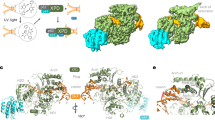Abstract
We expressed, purified, and characterized the helicase encoded by ORF1 of the Thermococcus nautili pTN2 plasmid (Soler et al. Nucl Acids Res 38, 5088–5104, 2010). The enzyme, which belongs to the SF1 family of helicases, possesses NTPase activity, with a strong preference for ATP and GTP as compared to CTP and TTP; dATP was also a substrate. Triphosphatase activity was strongly stimulated by single-stranded DNA and, to a lesser extent, by double-stranded DNA. Unwinding of duplexes comprising a fluorescent oligonucleotide was monitored by fluorescence polarization spectroscopy and by polyacrylamide gel electrophoresis. As observed for enzymes of the same family, pTN2 helicase displays a strong preference for duplexes comprising a 3′ single-stranded extension and proceeds from the 3′ to the 5′ end of the loading strand. Under the conditions of the in vitro assay, pTN2 helicase did not appear to be recycled, but stayed bound to single-stranded DNA, which explains why high concentrations of enzyme are required to unwind long stretches of duplex DNA. The helicase enhances the synthesis of double-stranded DNA by pTN2 primase and by T. nautili PolB polymerase primed by pTN2 primase but it did not enhance synthesis by Taq DNA polymerase.






Similar content being viewed by others
References
Bjornson KP, Moore KJ, Lohman TM (1996) Kinetic mechanism of DNA binding and DNA-induced dimerization of the Escherichia coli Rep helicase. Biochemistry 35(7):2268–2282. doi:10.1021/bi9522763bi9522763
Cheng W, Hsieh J, Brendza KM, Lohman TM (2001) E. coli Rep oligomers are required to initiate DNA unwinding in vitro. J Mol Biol 310(2):327–350. doi:10.1006/jmbi.2001.4758
Dillingham MS (2011) Superfamily I helicases as modular components of DNA-processing machines. Biochem Soc Trans 39(2):413–423. doi:10.1042/BST0390413BST0390413
Dillingham MS, Wigley DB, Webb MR (2000) Demonstration of unidirectional single-stranded DNA translocation by PcrA helicase: measurement of step size and translocation speed. Biochemistry 39(1):205–212
Gill S, Krupovic M, Desnoues N, Beguin P, Sezonov G, Forterre P (2014) A highly divergent archaeo-eukaryotic primase from the Thermococcus nautili plasmid, pTN2. Nucleic Acids Res. doi:10.1093/nar/gkt1385
Gorbalenya AE, Koonin EV (1993) Helicases: amino acid sequence comparisons andstructure-function relationships. Curr Opin Struct Biol 3(3):419–429
Ishino S, Fujino S, Tomita H, Ogino H, Takao K, Daiyasu H, Kanai T, Atomi H, Ishino Y (2011) Biochemical and genetical analyses of the three mcm genes from the hyperthermophilic archaeon, Thermococcus kodakarensis. Genes Cells 16(12):1176–1189. doi:10.1111/j.1365-2443.2011.01562.x
Krupovic M, Gonnet M, Ben Hania W, Forterre P, Erauso G (2013) Insights into dynamics of mobile genetic elements in hyperthermophilic environments from five new Thermococcus plasmids. PLoS ONE 8:e49044
Kumura K, Sekiguchi M (1984) Identification of the uvrD gene product of Escherichia coli as DNA helicase II and its induction by DNA-damaging agents. J Biol Chem 259(3):1560–1565
Machon C, Lynch GP, Thomson NH, Scott DJ, Thomas CD, Soultanas P (2010) RepD-mediated recruitment of PcrA helicase at the Staphylococcus aureus pC221 plasmid replication origin, oriD. Nucleic Acids Res 38(6):1874–1888. doi:10.1093/nar/gkp1153gkp1153
Maluf NK, Fischer CJ, Lohman TM (2003) A Dimer of Escherichia coli UvrD is the active form of the helicase in vitro. J Mol Biol 325(5):913–935
Matson SW (1986) Escherichia coli helicase II (urvD gene product) translocates unidirectionally in a 3′ to 5′ direction. J Biol Chem 261(22):10169–10175
Matson SW, George JW (1987) DNA helicase II of Escherichia coli. Characterization of the single-stranded DNA-dependent NTPase and helicase activities. J Biol Chem 262(5):2066–2076
Niedziela-Majka A, Chesnik MA, Tomko EJ, Lohman TM (2007) Bacillus stearothermophilus PcrA monomer is a single-stranded DNA translocase but not a processive helicase in vitro. J Biol Chem 282(37):27076–27085. doi:10.1074/jbc.M704399200
Sinha KM, Glickman MS, Shuman S (2009) Mutational analysis of Mycobacterium UvrD1 identifies functional groups required for ATP hydrolysis, DNA unwinding, and chemomechanical coupling. Biochemistry 48(19):4019–4030. doi:10.1021/bi900103d
Slatter AF, Thomas CD, Webb MR (2009) PcrA helicase tightly couples ATP hydrolysis to unwinding double-stranded DNA, modulated by the initiator protein for plasmid replication, RepD. Biochemistry 48(27):6326–6334. doi:10.1021/bi900101h
Soler N, Marguet E, Cortez D, Desnoues N, Keller J, van Tilbeurgh H, Sezonov G, Forterre P (2010) Two novel families of plasmids from hyperthermophilic archaea encoding new families of replication proteins. Nucleic Acids Res 38(15):5088–5104. doi:10.1093/nar/gkq236gkq236
Tanner NK (2003) The newly identified Q motif of DEAD box helicases is involved in adenine recognition. Cell Cycle 2(1):18–19
Toseland CP, Martinez-Senac MM, Slatter AF, Webb MR (2009) The ATPase cycle of PcrA helicase and its coupling to translocation on DNA. J Mol Biol 392(4):1020–1032. doi:10.1016/j.jmb.2009.07.071
Xu HQ, Zhang AH, Auclair C, Xi XG (2003) Simultaneously monitoring DNA binding and helicase-catalyzed DNA unwinding by fluorescence polarization. Nucleic Acids Res 31(14):e70
Zhang W, Dillingham MS, Thomas CD, Allen S, Roberts CJ, Soultanas P (2007) Directional loading and stimulation of PcrA helicase by the replication initiator protein RepD. J Mol Biol 371(2):336–348. doi:10.1016/j.jmb.2007.05.050
Acknowledgments
We thank Mart Krupovic for helpful discussions and critical reading of the manuscript. S. G. was supported by grant DARRI AO2010 from the Direction des Applications de la Recherche of Institut Pasteur (DARRI).
Author information
Authors and Affiliations
Corresponding author
Additional information
Communicated by H. Atomi.
Rights and permissions
About this article
Cite this article
Béguin, P., Baron, B., Gill, S. et al. The SF1 helicase encoded by the archaeal plasmid pTN2 of Thermococcus nautili . Extremophiles 18, 779–787 (2014). https://doi.org/10.1007/s00792-014-0658-5
Received:
Accepted:
Published:
Issue Date:
DOI: https://doi.org/10.1007/s00792-014-0658-5




